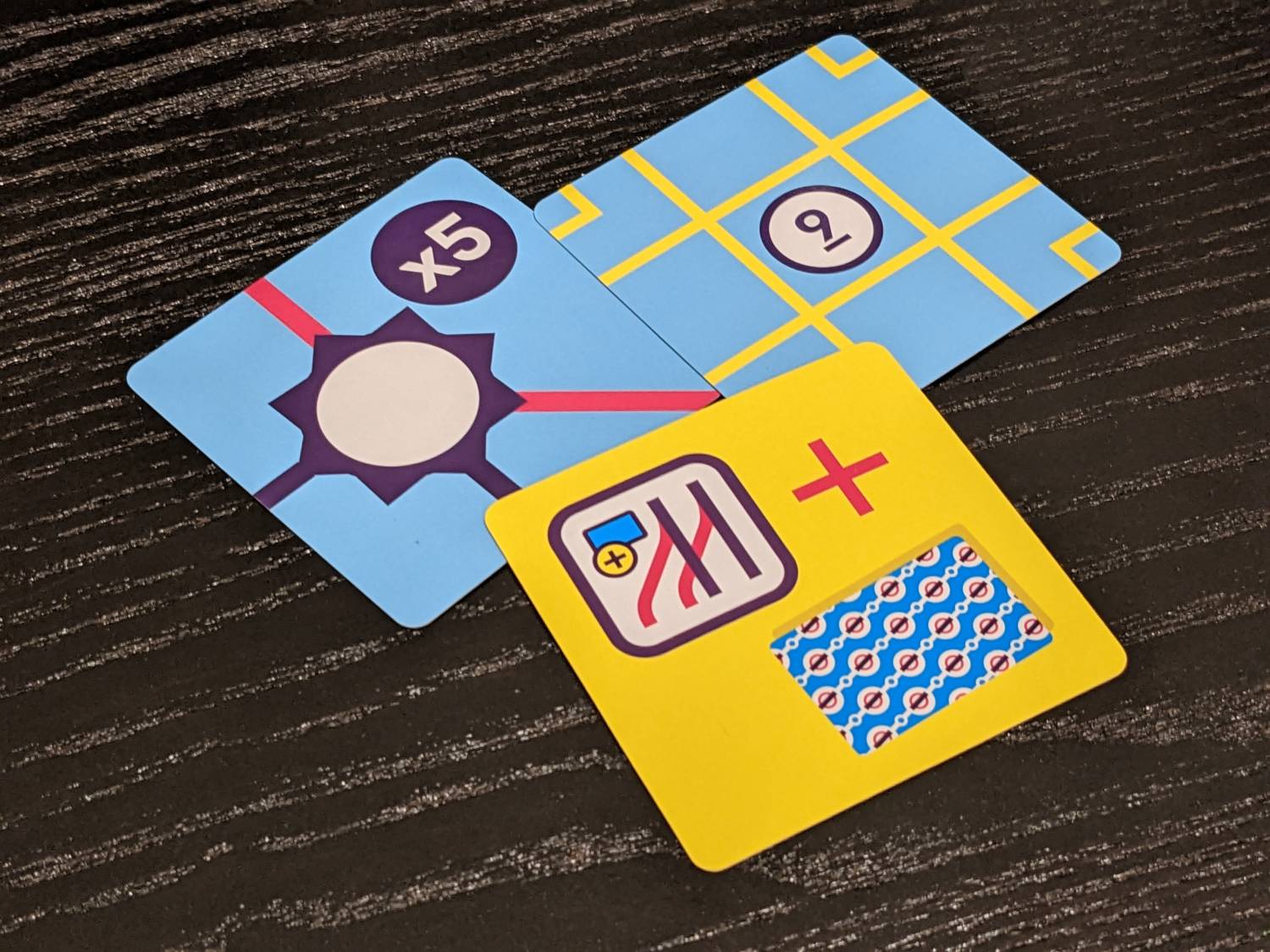It has been an interesting year of roll-and-write (RNW) and flip-and-write (FNW) games. Dinosaur Island Rawr ‘N Write is probably my favorite game in this category, although Railroad Ink: Deep Blue Edition is the people’s choice here at home. Twilight Inscription? Disaster.
I enjoyed my plays of Welcome To… years ago, and I love (and still own) my copy of Cartographers. Both of these FNW games compare well as light/family weight experiences, so when I had the chance to get Next Station: London (2022, Blue Orange Games) to the table, I didn’t hesitate to get it into the review game rotation quickly as a filler between some of the other heavier games on my list.
Next Station: London has a simple concept and comes from a publisher that I have generally enjoyed (Paco’s Party, Kingdomino: Origins). Like the art design of Zoom in Barcelona—another Blue Orange production—I love the look and clean lines of the cover art on the Next Station: London box.
But the game was a mixed experience.

Four Pencils
Next Station: London borrows some of the same concepts from a game called Let’s Make a Bus Route (released in the US as Get on Board, a Japanese production where all players have to react to the same flipped card to make a bus route in their color around a shared map of Tokyo.
In Next Station: London, everyone has their own copy of the same map of London, but only one of the four colored pencils available to a player each round. On this map, there are four starting stations, in green, yellow, pink and purple, matching the four pencils available to the players. Each round, a player—representing an architect who has to build the best subway network—will have one of these pencils before rotating it to the next player in clockwise order.
Players will be reacting to the shapes displayed on one of the 11 cards flipped each action. Five of these 11 cards are in a unique color, and when the fifth of these cards is played, the round is over. This means that each player will be able to take between 5-10 actions on a turn. (The 11th card is special, and I’ll get to that in a moment.)
Your actions are simple: starting from your current pencil color station, and viewing the action’s current card shape (circle, square, triangle, or pentagon, aligning with the station shapes on each player’s sheet), players must draw a single line along the gray pre-printed lines from one shape to one matching the currently flipped card. On future cards, you’ll only be able to draw lines from one of the two ends of your subway line. If you can’t or don’t want to draw a line, you could pass, but your score will likely take a hit as a result.
One other way you can draw your network: if you draw the Railroad Switch card after the first or second turn of the round. In this way, you can intentionally draw a line from the middle of your existing network into other parts of your map.
Scoring is interesting. Sprawl is rewarded well in Next Station: London. You are encouraged to draw a network as wide as possible within each color, as well as finding ways to connect multiple sections in one of the 13 sections used for scoring. You’ll also score bonus points for hitting tourist destinations on your line, as well as creating stations that have multiple colors running through them.

The Drawbacks
When I first opened Next Station: London—and it is a handsome production, right down to the magnetic metal closing lid—I was worried about a few things, which turned into concerns tied to the game’s level of endurance.
There is only a single map included in the game, so all 200 sheets of paper feature the same problem to solve. This, mixed with the limited number of cards, gives me the sense that after a half-dozen plays, Next Station: London might not be very interesting. (I’m already four plays in and it’s starting to feel a little dry.)
Let’s Make a Bus Route gets around some of this by making each player’s game a bit different. There are only 12 cards to flip in the game, but each card number represents a different shape that needs to be drawn. And the map is shared, creating a comedic list of issues as players’ routes all run into each other.
I would have preferred more options for the maps, but maybe that would have increased the cost of the game. Still, my environmentally friendly side tells me that Blue Orange could have used dry erase boards and markers if the game is always going to feature the same map and they could use a box size similar to the one provided.
The Railroad Switch card makes things interesting, as long as it arrives after the second flipped card. But there’s a 9% chance that it will show up as your first draw, which means it gets discarded. I have found that leads to an interesting problem when trying for high scores—the scores seem like they will be higher if you can use the exchange card. The Railroad Switch card and the two “Joker” cards (which give players the right to use any of the four station symbols) are easily the most important ones in the game to provide flexibility, so if they show up, scoring bonanzas may occur.
None of these things break the game, but Next Station: London is already a limited operation. Giving it as many chances to shine as possible would be nice, right?

Hence, The Bonus Modules
Next Station: London has two mini expansions in the box, Shared Objectives and Pencil Powers. Even if you are not a seasoned gamer, I would suggest using those expansions right out of the box. If you are playing this game with the family at the beach, the base game will be enough especially since you won’t play this more than a few times.
Shared Objectives is a must; this gives players two different milestones to try and achieve over the course of play, and provide a little bit of direction each round. They are very easy to include. One rewards players for connecting to all five tourist destinations, while another grants a bonus for crossing the Thames six times during the game.
Pencil Powers are very minor and can help newer players break the rules once per round. Each color pencil is assigned a once-per-round power that can be used to score extra stations, use a wild Joker symbol in a pinch, or even adding a second section of track on a single turn.
These mini modules add a little variety to Next Station: London, but not enough.

Mind the Gap
If your goal is finding a fun route-building game set in London, Get on Board: New York & London is a more interesting game with a bit more replayability. Next Station: London makes for a fun puzzle for an afternoon or two, but I am having a hard time imagining a world where I play it 20-30 times.
Despite a massive rules pamphlet (given the weight of the game), Next Station: London is fairly easy to teach and does look nice on the table for a quick flip-and-write experience. I just wish I wanted to play it more.
Still, this beats going to London right now, because flying to Heathrow is a bear!!












Add Comment